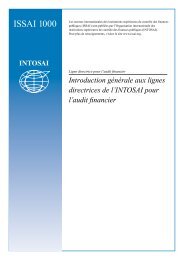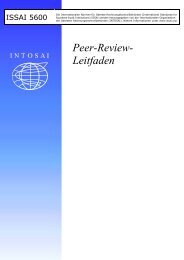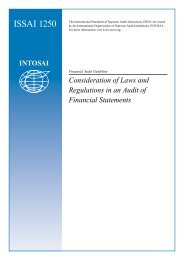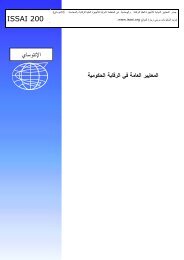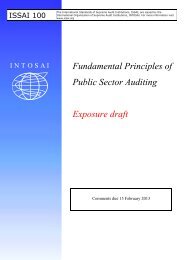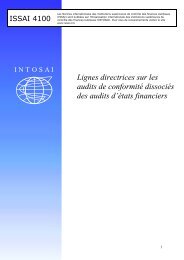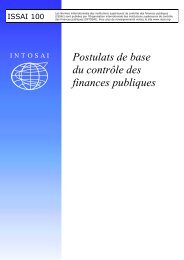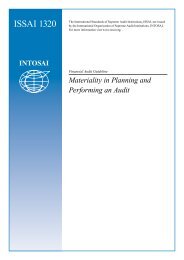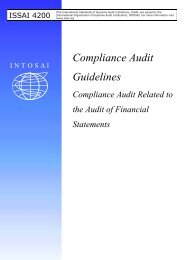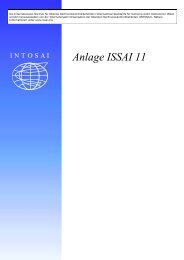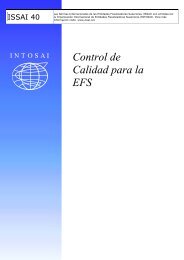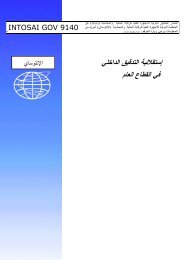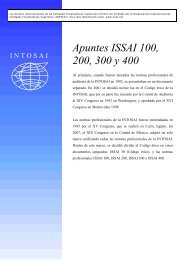ISSAI 1240
ISSAI 1240
ISSAI 1240
You also want an ePaper? Increase the reach of your titles
YUMPU automatically turns print PDFs into web optimized ePapers that Google loves.
<strong>ISSAI</strong> <strong>1240</strong><br />
ISA 240<br />
THE AUDITOR’S RESPONSIBILITIES RELATING TO<br />
FRAUD IN AN AUDIT OF FINANCIAL STATEMENTS<br />
Similarly, the processing of journal entries and other adjustments may<br />
involve both manual and automated procedures and controls. Where<br />
information technology is used in the financial reporting process,<br />
journal entries and other adjustments may exist only in electronic form.<br />
• The characteristics of fraudulent journal entries or other adjustments –<br />
inappropriate journal entries or other adjustments often have unique<br />
identifying characteristics. Such characteristics may include entries (a)<br />
made to unrelated, unusual, or seldom-used accounts, (b) made by<br />
individuals who typically do not make journal entries, (c) recorded at the<br />
end of the period or as post-closing entries that have little or no<br />
explanation or description, (d) made either before or during the<br />
preparation of the financial statements that do not have account numbers,<br />
or (e) containing round numbers or consistent ending numbers.<br />
• The nature and complexity of the accounts – inappropriate journal<br />
entries or adjustments may be applied to accounts that (a) contain<br />
transactions that are complex or unusual in nature, (b) contain<br />
significant estimates and period-end adjustments, (c) have been prone to<br />
misstatements in the past, (d) have not been reconciled on a timely basis<br />
or contain unreconciled differences, (e) contain inter-company<br />
transactions, or (f) are otherwise associated with an identified risk of<br />
material misstatement due to fraud. In audits of entities that have<br />
several locations or components, consideration is given to the need to<br />
select journal entries from multiple locations.<br />
• Journal entries or other adjustments processed outside the normal<br />
course of business – non standard journal entries may not be subject to<br />
the same level of internal control as those journal entries used on a<br />
recurring basis to record transactions such as monthly sales, purchases<br />
and cash disbursements.<br />
A44. The auditor uses professional judgment in determining the nature, timing and<br />
extent of testing of journal entries and other adjustments. However, because<br />
fraudulent journal entries and other adjustments are often made at the end of a<br />
reporting period, paragraph 32(a)(ii) requires the auditor to select the journal<br />
entries and other adjustments made at that time. Further, because material<br />
misstatements in financial statements due to fraud can occur throughout the period<br />
and may involve extensive efforts to conceal how the fraud is accomplished,<br />
paragraph 32(a)(iii) requires the auditor to consider whether there is also a need to<br />
test journal entries and other adjustments throughout the period.<br />
Accounting Estimates (Ref: Para. 32(b))<br />
A45. The preparation of the financial statements requires management to make a<br />
number of judgments or assumptions that affect significant accounting<br />
estimates and to monitor the reasonableness of such estimates on an ongoing<br />
27<br />
262 The Auditor’s Responsibilities Relating to Fraud in an Audit of Financial Statements



